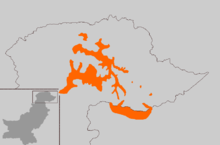Shina people
 Ethnic Groups in Pakistan (Dark Orange Area in Pakistan and India) | |
| Regions with significant populations | |
|---|---|
| Gilgit Baltistan, Kashmir | |
| 2,084,673 (in 2004) | |
| 185,720 | |
| Languages | |
| Shina | |
| Religion | |
|
Shi'a Islam (majority) Sunni Islam (minority) | |
| Related ethnic groups | |
| Dardic peoples | |
The Shina are the Dardic, pre-Islamic tribe originating in southern Gilgit–Baltistan, Chitral and western part of Kohistan district in Khyber Pakhtunkhwa province of Pakistan, as well as Dras Valley and Gurais/ Kishenganga Valley region in northern Kashmir of India. They also live in some parts of Pakistani Kashmir. They speak an Indo-Aryan language, called Shina language, with varied dialects.
The part of the Indus Valley below Gor to the Pak-Afghan border near Ghorband is called Shinkari and its Southernmost part is home to the purest Shin community known. The name Shin-kari still exists in Pakhli, and the Shin-kari family's original home may have been in that valley. The Shins form the majority of the population in Gor, Chilas, Tangir, the Indus Valley below Sazin, and the upper part of the Gilgit Valley above Ponyal.[1]
History
It has been confirmed that the Shina people have been living in this place from more than six thousand years. In 4th century, the Greek historian Herodotus described an ethnic group who spoke the Brokpa language and lived on the Deosai Plateau of Gilgit-Baltistan.
Languages
Shina, is an Indo-European language used by the Shina peoples; they also use the Brokskat dialect.
Pre-Islamic Hindu Shin names
| “ | Of the Shin names a great number have the suffix of Sing, which is retained in spite of the conversion of the people to Islam. These named are never found among the purely Boorish population of Hunza and Nager, but it is to be noted that the Suffix Sing is found among the earlier Makpon Kings of Iskardo. The suffix is local version of Hindu Surname Singh which coms from Sanskrit word Simha meaning Lion. It is generally used by Rajputs or Kshatriya ruling class.[2] | ” |
Shin Names Men
| Moosing | Hubba Sing | Ram Sing |
|---|---|---|
| Kummosing | Gissing | Poonyar Sing |
| MelSing | Chumar Sing | Singoo |
| Dem Sing | Boonyal Sing | Dingoo |
| Hinnasing | Gelsing[3] |
Shin Names Women
| Sheli Bai | Sookoomull | Rozi Bai |
|---|---|---|
| Shubibi | Bibi | Shermull |
| Shoosha Bai | Bai[4] |
In the world's second coldest place Drass, one can find such names which were used in prehistoric period. This shows that these Dards are the linguistic descendents of regvedic culture. besides, innumerable Sanskrit words are found, such as Bakhuni, shish mukh, achikot, maran, suri, rajju, drusht, jar, jarat, pachak. According to the local Dard historians, a band of seven brothers migrated from Dardistan, probably either from Dasu or from Chilas. These Aryan brothers marched towards Deosai Plateau and reached Karkit. By finding there suitable pastures and water resources they decided to settle there. This happened probably in the seventh or eighth century. Today their descendents are found here in the thousands. They had kept their Shina language and culture alive. These seven earlier Dard people were Cholok Lacho, Suko, Sangyun, Khori, Sacho and Prato. Their forefather's name was Ra Thatha Khan, and their father was Suri Pueinlo. So for even today they are called Suri Puinlay.
Festivals
Chili marks commencement of wheat sowing which is similar to wheat sowing celebrations all over the Indian subcontinent with different names like Lohri and Makar Sakranti. Chilli also had years ago a further connection with the worship of the Cedar, now in the main dropped.[5]
Ceder worship is prevalent among all historic Hindu communities of Himalayas from Hindu Kush region to Himachal and Uttarakhand. It is known as Deodar derived from Sanskrit word Devadaru, which means "wood of the gods", a compound of deva (god) and dāru (wood, etym. tree). The Cedar is also sacred in Kafiristan.[6] Like the one described above. The Drassi Dards also celebrate chilli ceremony, lomay, nisalo. The people of Gilgit Baltistan,chilas are celebrate, ″—— spring fastivel, summer fastivel,
See also
References
- ↑ A glossary of the tribes and castes of the Punjab and NorthWest provinces, compiled by H.A. Rose, vol III Page 405
- ↑ Tribes of the Hindoo Koosh John Biddulph Sang e meel Publications Page 99
- ↑ Tribes of the Hindoo Koosh John Biddulph Sang e meel Publications Page 99
- ↑ Tribes of the Hindoo Koosh John Biddulph Sang e meel Publications Page 99
- ↑ The making of a frontier Five years' experiences and adventures in Gilgit By Algernon George Arnold Durand Page 210
- ↑ The making of a frontier Five years' experiences and adventures in Gilgit By Algernon George Arnold Durand Page 209